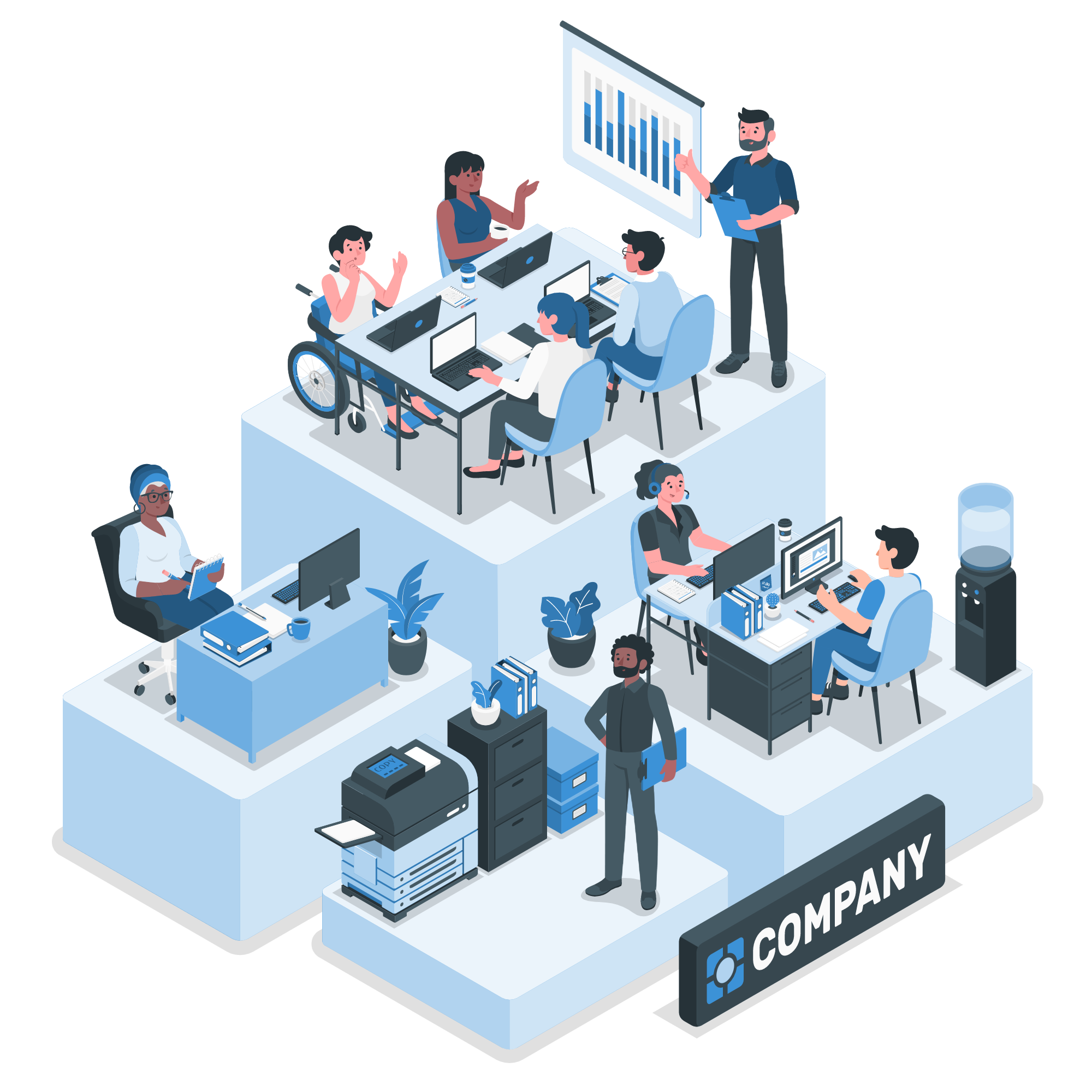Job satisfaction is the level of pleasure or fulfillment an employee feels toward their job. It is an important aspect of any business, as satisfied employees tend to be more committed, productive, and are significantly more likely to stay in their roles long term. One of the key responsibilities of a manager is to ensure that all employees are treated with respect and fairness, regardless of their level or role within the company. Every employee plays a vital role in the business, so ensuring a respectful and supportive environment directly contributes to their satisfaction.
The main factors that influence job satisfaction include pay and compensation, overall benefits, job security, and the trust between employees and senior management. When employees feel secure and fairly compensated, and when leadership communicates openly and respectfully, it strengthens their connection to the organization.
Additionally, offering and effectively managing paid time off (PTO) is a critical part of maintaining job satisfaction. Using an employee vacation tracker helps streamline PTO requests, prevent scheduling conflicts, and ensure employees are taking the rest they need. This not only improves transparency and trust but also supports a healthy work-life balance, an increasingly important factor in how employees measure satisfaction in their roles.
10 most important tips to maintain job satisfaction in your team
We can maintain job satisfaction in the team members by following the tips given below:
Appreciate the work and efforts
As a manager, you must find time to make your team members feel appreciated and affirmed. Celebrate their small successes and acknowledge their larger accomplishments. Even if you work remotely, think of ways you can boost your employees’ feelings of pride and accomplishment. This should be one of your highest priorities as a manager because most employees don’t feel they get enough praise.
Focus on the long run
You have to focus on directing the team members towards the vision of the organization because when team members and employees see the big picture, the organization’s goals, vision, and strategy, they feel connected to the organization. They see how they can contribute to achieving those goals, leading to increased job satisfaction.
Communicate openly
As a manager, when you express your opinions, your team will be more likely to do the same. In your conversations with team members, share information regarding progress and setbacks. This makes them feel connected to the workplace and maintains their job satisfaction.
Take an interest in your employees’ well-being
Managers should check in with employees on how they are doing. Making time for one-on-one meetings can help you build a relationship with your employees. That helps them feel heard and improves the quality of their work.
Give them opportunities to grow
This plays the main role in maintaining job satisfaction. When employees stop learning, they might consider looking for another job. Managers can give their employees something to learn by encouraging them to attend conferences, webinars, and seminars; mentoring; and offering internal programs. They should also keep the mindset of curiosity and learning high in interns doing a job and in employees building a career.
Share feedback regularly
Feedback is a crucial part of the employee-manager relationship. Having unstructured feedback sessions, held regularly and often, is ideal. Give your employee regular constructive feedback sessions to show that you are invested in his or her professional development. The best ways to give healthy feedback are
- The positive intent
- Constructive
- Genuine
- Regular
Form positive relationships
It’s easy to overlook the power of a positive relationship. It helps if managers take time to nurture these relationships with employees and colleagues. When we work well together, both we and our businesses get benefited. Collaboration is more effective, and we create a sense of trust that strengthens our teams. It’s a fact of life that happy employees are more productive than unhappy ones. One way to put a smile on employees’ faces is to get them to be friends. Nothing beats having someone around with whom you can talk about things other than work.
Give your employees room for promotion
As promotion and career growth is the main factor of job satisfaction, the manager should always keep this into consideration. As an employer, you can help your employees plan for their long-term success. This shows them that you are committed to seeing them progress and that you’re willing to invest in their career growth. Encourage your employees to map out their career goals so they can transition from a job to a career.
Rewards, Recognition, and Performance bonus
Monthly salaries are fair, but when it comes to rewarding productivity and results, it becomes the best to do for your employees’ job satisfaction. Money talks, and an employee who feels underpaid will be less likely to try hard at his job. Book rewards and recognition to motivate your workforce and you’ll see an increase in productivity.
Ensure job security
Employers can help workers feel more secure about their jobs by communicating with them about the financial state of the company, its objectives, and its performance. When employees know their employer is doing well financially, they feel more secure about their job.
To ensure job satisfaction for employees, many organizations conduct biannual or yearly employee engagement surveys that address topics like teamwork, feedback, information, work-life balance, and work relationships. The organization can so work on maintaining job satisfaction by providing the data from the surveys.
Frequently Asked Questions (FAQ) About Job Satisfaction
Why is job satisfaction important for employee retention and productivity?
Job satisfaction plays a crucial role in both employee retention and workplace productivity. When employees are satisfied with their work, they are more engaged, more committed to the company’s goals, and more likely to stay for the long term. Satisfied employees take pride in their roles, demonstrate loyalty, and are motivated to give their best effort, resulting in higher quality work, improved customer service, and lower turnover rates.
On the contrary, low job satisfaction can lead to absenteeism, poor morale, reduced productivity, and ultimately, high recruitment and training costs for the organization. Investing in job satisfaction is not just an HR initiative, it’s a strategic business decision that influences long-term success.
What are the top contributors to job satisfaction in a workplace?
Several key factors contribute significantly to employee job satisfaction. These include:
-
Competitive pay and benefits: Fair and timely compensation, along with comprehensive benefits such as health insurance, PTO, and retirement plans.
-
Career development opportunities: Opportunities for skill-building, promotions, and professional growth are essential.
-
Workplace culture: A positive, inclusive, and respectful workplace fosters satisfaction.
-
Managerial support: Supportive, communicative, and empathetic leadership improves employee engagement.
-
Recognition and rewards: Employees feel more satisfied when their contributions are acknowledged.
-
Work-life balance: Flexibility in working hours, time-off policies, and wellness programs help maintain balance.
-
Job security: Knowing their role is secure allows employees to focus on performance rather than fear.
Organizations that consistently work on improving these areas tend to have happier, more productive teams.
How can managers improve job satisfaction among team members?
Managers have a direct influence on employee morale and job satisfaction. Here are a few actionable ways managers can make a difference:
-
Recognize achievements regularly through verbal praise, awards, or bonuses.
-
Communicate transparently about team goals, company updates, and performance expectations.
-
Provide growth opportunities, such as mentoring, training, and career path planning.
-
Encourage autonomy and give employees ownership over their work.
-
Support employee well-being, both professionally and personally, through regular check-ins.
-
Solicit feedback and act on suggestions where feasible.
-
Create a positive team environment by encouraging collaboration and mutual respect.
Managers who build trust and nurture their teams not only increase satisfaction but also foster a sense of loyalty and belonging.
What role does feedback play in maintaining job satisfaction?
Feedback is an essential component of employee satisfaction. When delivered consistently and constructively, feedback helps employees:
-
Understand expectations
-
Recognize their strengths
-
Identify areas for improvement
-
Feel supported in their career development
Regular feedback promotes a culture of transparency and growth. It reassures employees that their performance is being noticed and evaluated fairly. On the other hand, a lack of feedback can lead to confusion, disengagement, and even resentment.
Managers should balance constructive criticism with positive reinforcement and create an environment where feedback is welcomed from both directions.
How can job satisfaction be measured effectively in an organization?
The most effective way to measure job satisfaction is through regular employee engagement or satisfaction surveys. These surveys typically cover areas such as:
-
Communication
-
Managerial support
-
Work-life balance
-
Team collaboration
-
Recognition
-
Career growth opportunities
In addition to surveys, organizations can track turnover rates, internal promotions, absenteeism, and feedback from exit interviews. Conducting stay interviews, where you ask current employees what motivates them to remain, can also provide insight.
Survey results should be analyzed and followed by actionable changes. This shows employees that their voices matter and helps boost engagement in future surveys.
Conclusion
Job satisfaction is not just a feel-good metric, it’s a cornerstone of a successful, resilient, and high-performing workplace. When employees are fulfilled in their roles, they bring energy, creativity, and dedication that drives the company forward.
From recognizing achievements and offering growth opportunities to improving communication and job security, there are countless ways organizations and managers can positively influence job satisfaction. It starts with intentional leadership, a culture of appreciation, and the willingness to listen and adapt based on employee needs.











